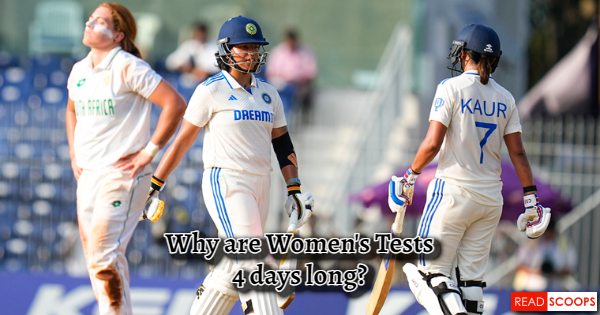Why is women’s Tests cricket only 4 days?
Test cricket, the pinnacle of cricketing endurance, is a five-day battle between bat and ball. However, for women’s cricket, the format takes a slightly different shape. Women’s Test matches are played over just four days, sparking debate and raising questions. Here on this page, we take a deeper dive into the reasons behind this format and the ongoing discussions for change.

Women’s Test Cricket – Player fitness
The tradition of four-day women’s Tests dates back to the sport’s early days. In the 1930s, when women’s Test cricket emerged, concerns surrounded player fitness for a five-day match. The physical demands were thought to be more taxing on women compared to men. While fitness levels in women’s cricket have risen considerably in more recent years, this historical precedent continues to influence the format.
Economics of Women’s Tests
Scheduling women’s Tests presents logistical challenges. National cricket boards prioritize revenue-generating formats like T20s. Fitting a five-day Test into tight international calendars can be difficult, especially with fewer women’s Test-playing nations compared to men. Even men’s Test cricket generates lesser revenue than the shorter formats.
Why do they make the women’s test matches only 4 days when clearly it’s the men who don’t deserve 5 days
—
Stu
(@stuwhy) February 11, 2023
Additionally, broadcasters might be hesitant to commit resources to a longer format with potentially lower viewership. The Board of Control for Cricket in India (BCCI) has tried to make the women’s game more popular in recent years for Indian women’s cricket, offering free entry to stadiums to fans who want to watch women’s cricket matches.
SEE ALSO: List of top online sports betting websites
Does the women’s game need 5 days?
Statistically, there’s an argument for keeping the four-day format. Women’s Test matches often see results – a win or a draw – within the current timeframe. Let’s look at the most recent 2023/24 season where three Tests were played until June 2024 (IND vs ENG, IND vs AUS, AUS vs SA), and all three ended up having results.
How much these women deserved to have a 5-day test! No hustle to declare, no extra pressure of pulling off a result in 4 days.
5-day test should be a norm, test cricket itself should be a norm in women’s cricket. The top teams must play test more often.
— Ritwika Dhar (@RituD307) June 25, 2023
However, some argue that a five-day format could allow for more dramatic finishes and a truer test of cricketing skills. The additional day could provide a better chance for a team to chase down a challenging target or stage a remarkable comeback, like we often see in the men’s game as well.
The future of women’s Tests
The debate on the ideal length is ongoing. There’s a growing sentiment that women’s Test matches deserve a 5-day platform, mirroring the men’s game. This could enhance the prestige of the format and showcase the full range of cricketing talent possessed by women players. Here are some potential solutions for a move to five days:
- Stronger domestic structures: Building a robust domestic first-class system for women could provide more experience with the longer format, improving fitness and skills.
- Shorter intervals: Compacting breaks between Tests in multi-match series could create space for an extra day without significantly extending the overall tour schedule.
- Increased viewership: Growing the fanbase for women’s Test cricket can incentivize broadcasters to invest in the format, making five-day Tests more financially viable.
The four-day format for women’s Test cricket is a product of historical assumptions and logistical constraints. While it delivers results, there’s a push to elevate the women’s game by adopting a five-day schedule. By prioritizing scheduling, building domestic structures, and attracting a wider audience, women’s Test cricket can truly thrive in its full five-day glory. For similar cricketing news from around the world, stay tuned to ReadScoops.com.
Signup to CBET.gg and get 200% exclusive welcome sports bonus




